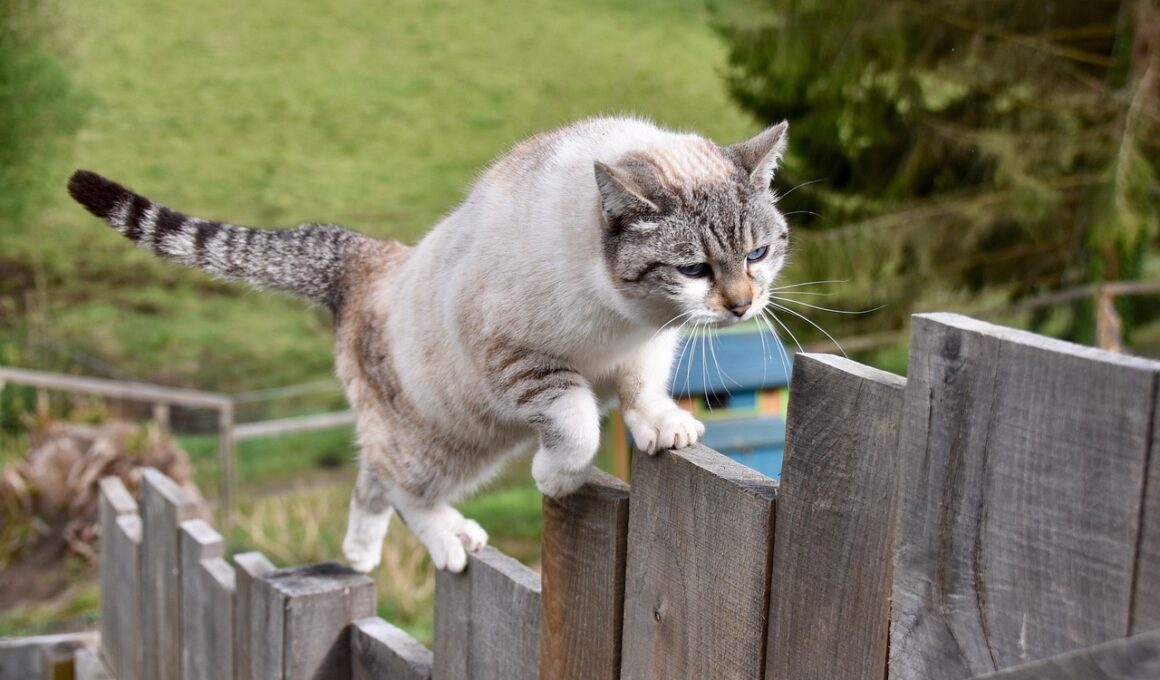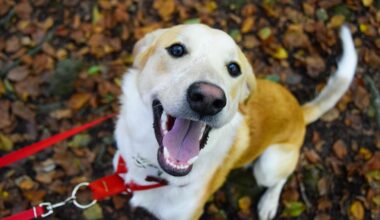Maintaining Your Cat’s Health and Fitness for Agility Sports
Agility sports for cats involve various physical challenges and mental stimulation, requiring optimal health and fitness. Engaging in these activities can improve your cat’s overall well-being, coordination, and socialization, ensuring they enjoy a meaningful and active life. Establishing a tailored training routine focused on agility helps in maintaining your feline’s weight, as excess weight can hinder performance. Begin by gradually introducing exercises to improve flexibility and strength. Utilize tools like tunnels, jumps, and weave poles, designed for agility training. Always keep your training sessions fun to ensure your cat remains engaged. Additionally, consider enhancing their dietary habits, favoring protein-rich foods to support muscle development. Regular health check-ups guarantee any emerging issues are detected early. Cats require mental stimulation, so integrating playtime with their training routine enhances overall fitness. Participating in agility competitions further stimulates your cat, encouraging continuous learning and improved skills. Ultimately, proper training, nutrition, and mental exercises create a harmonious balance vital for success in agility sports. Understanding your cat’s personality aids in customizing equipment and activities suitable for their unique character, further enriching their training experience.
Nutrition plays a pivotal role in your cat’s agility training regime. Maintaining a balanced diet ensures enough energy is available during practice and competitions. Cats are obligate carnivores, meaning their diet should be rich in quality animal proteins. Supplementing with essential nutrients, vitamins, and minerals supports overall health, boosting their stamina and agility. In addition, addressing hydration is crucial. Ensure fresh water is always accessible, particularly during intense training or hot weather. If your cat transitions between various activity levels, adjust their portions to maintain optimal body weight. Portion control helps in managing obesity, promoting performance improvements. Also, monitor any food allergies your pet may have and consult your veterinarian for tailored dietary advice. Transitioning to specialized dietary formulations designed for active cats may also be beneficial. Incorporating various food forms such as wet and dry can maintain interest in mealtime and avoid monotony. Furthermore, feeding schedules might need slight adjustments according to training intensity. Analyze your cat’s eating habits and adjust their diet accordingly to build an optimum nutritional foundation, which can significantly impact their agility performance.
Physical Fitness and Conditioning
Building your cat’s physical fitness is crucial before introducing them to advanced agility challenges. Gradually enhance their endurance through consistent conditioning routines. Start with short sessions focusing on basic skills like jumping and running, progressively increasing difficulty levels as your cat becomes more comfortable. Two critical aspects of feline fitness involve stretching and cardiovascular conditioning. Incorporate dynamic warm-ups before training sessions, prioritizing yoga-like stretches aimed at improving flexibility and mobility. Encourage your cat to engage in various activities; exploring different environments inspires curiosity while promoting agility. Exploring trails and parks offers unique terrains to practice skills. A kitten’s playful leaps help develop their lunging efficiency and speed. Maintain attention during training to ensure effective learning while preventing unnecessary stress or injuries. Observe your cat’s body language throughout workouts to gauge their energy levels and motivation. Vary circuits to keep sessions stimulating, including different obstacles and challenges. Practicing frequently will build muscle memory through repetition, reinforcing their learning. The conditioning foundation set now will enhance your cat’s agility performance during competitions. Ultimately, patience and persistence in training yield fruitful results when paired with thoughtful physical conditioning.
Agility training not only enhances physical fitness but also mental stimulation for your cat. Felines thrive on challenges that engage the mind, helping to boost overall focus and performance during agility events. Introduce games that require problem-solving, such as puzzle toys or automatic treat dispensers. These innovations inspire mental engagement and help develop necessary skills like patience and coordination. Train your cat to respond to various verbal commands or poses to improve their listening skills. Consider adding some fun exercises tailored to different skill levels, focusing on various obstacles. Training in different environments further aids mental adaptation by exposing them to various distractions. Prioritize short practice sessions to maintain your cat’s enthusiasm, gradually lengthening them as skills improve. Gradual exposure to environmental challenges encourages regular focus during training. Keep sessions upbeat with praise and treats as positive reinforcement, encouraging persistence even after failures. Observe how they respond to various exercises, modifying them to suit your cat’s personality. Building a strong bond with your cat strengthens the training dynamic, leading to improved outcomes in agility competitions, creating a rewarding learning environment. Consult local agility instructors for further support or advice.
Preventing Injuries
Injuries can severely hinder your cat’s agility training journey. To mitigate risks, prioritize a gradual progression in exercises, not overwhelming your cat’s developing muscles or joints. Recognizing your pet’s limitations is essential; every cat has unique skills and thresholds for various activities. Regularly monitoring their performance in training helps identify potential issues early. Incorporate a consistent warm-up and cool-down routine to promote muscle recovery. Check your training area for obstacles that may pose hazards, ensuring surfaces are safe and suitable. Using proper agility equipment is crucial in preventing injuries; invest in high-quality items designed specifically for feline agility. Allow rest days as vital recuperation periods that prevent overexertion and related issues. A sudden change in exercise intensity can lead to muscle strains or sprains. Encourage quiet, comfortable resting places in your home where your cat can feel secure. In case of signs of pain or discomfort, consult your veterinarian immediately to address any health concerns. Continuing to keep a close eye on training techniques and practicing safe measures reduces injury risks. Supporting your cat’s journey in agility sports involves promoting a holistic approach rooted in safety and well-being.
Socialization plays a significant role in your cat’s agility training and overall well-being. Engaging with others allows them to develop their interactive skills, creating more enjoyable training sessions. Introduce your cat to other friendly pets and their owners, forming bonds that enrich their social experiences. Socialization helps build confidence in various situations and familiarizes them with new environments, essential in agility competitions. Attending local classes or workshops designed for feline agility allows time spent with other owners and pets, enriching their skills while learning new techniques. Incorporating group training sessions can also enhance motivation, translating into better agility performance. Balancing training with playtime enhances the bond between feline and owner; make sure to reward their accomplishments generously. Throughout their journey, support from family members and friends further encourages their development. Join online communities focused on feline agility to share experiences and gain valuable insights, maintaining enthusiasm and fostering a sense of belonging. Regular socialization will not only sharpen your cat’s agility skills but also improve their adaptability in various settings. Over time, well-socialized cats tend to excel further in both competition and everyday life.
The Role of Regular Veterinary Check-Ups
Your cat’s health is paramount, particularly when participating in agility sports. Regular veterinary check-ups provide essential screenings to ensure they maintain peak physical condition. During these visits, vaccinations and preventative medications can be administered to protect against common illnesses. Comprehensive health assessments also allow your veterinarian to advise precisely on any areas requiring particular attention, such as diet or exercise. Beyond check-ups, address any changes in behavior, such as decreased energy, reluctance to exercise, or changes in appetite promptly, ensuring your cat’s optimal welfare. Working closely with your vet promotes a long-term strategy for maintaining health, further preparing your feline for agility challenges. In case of injuries or specific concerns, veterinary expertise can guide injury prevention or treatment if needed. Consider arranging dental check-ups regularly, as oral health is vital and often overlooked. Veterinary advice on appropriate flea and tick treatments can help avoid adverse reactions during outdoor training sessions. Ultimately, the guidance offered by your veterinarian is invaluable, emphasizing the importance of regular check-ups to maintain your cat’s overall health. A proactive partnership with veterinary professionals altogether directly supports successful agility performance and longevity in the sport.
Participating in seasonal agility events allows you and your cat to enjoy the fruits of your diligent training efforts. These events foster a great environment where you can meet fellow enthusiasts, share delightful experiences, and support each other during competitions. Local agility clubs often organize events, giving opportunities to showcase your cat’s talents; thus, consider joining one. Celebrating achievements together can further strengthen your bond, marking the culmination of your hard work. Besides competitions, participating in fun runs or charity events gives you the chance to enjoy the outdoors while contributing to your community. Always remember that the primary goal of your training is to cultivate a positive and rewarding experience for your cat, fostering a joyful approach to agility. The rewards of perseverance, patience, and commitment will manifest themselves in improved performance and a stronger connection with your beloved feline. Despite the challenges presented along the way, taking measured steps allows you to overcome hurdles. Through agility training, you’ll experience numerous cherished memories that will last a lifetime. In the end, success comes not only from performance but also from the love you pour into this rewarding journey together.


